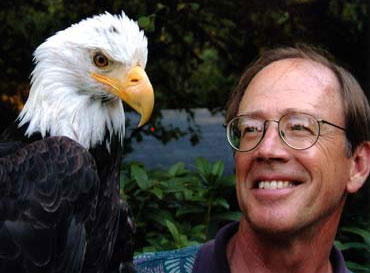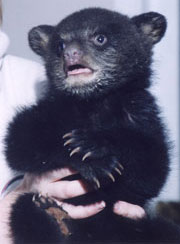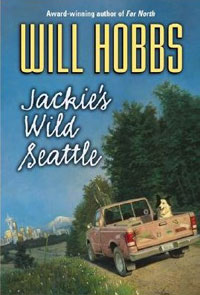 |
A newspaper clipping. My brother-in-law in Seattle was aware that I'm always cutting articles out of newspapers and magazines—just anything that catches my fancy. You never know what might turn into a story! The clipping he sent was about a volunteer for a wildlife rescue and rehab center who rescued a wild coyote from an elevator in a downtown Seattle office building. Amazingly enough, the man did it without tranquilizing the animal. He just sat down in the elevator with the coyote, talked to it, calmed it down and brought it out in a carrier. I resolved to visit the wildlife center the next time I was in the area, and to meet these amazing people.
This was different for you, writing a novel set in and around a big city, after so many novels that take place in the wilderness. That was a lot of the appeal. I could set a story about wildness, and young people's concern for wildlife, in the sort of location where many of my readers live. I've been visiting Washington state for many years, have relatives there, and have gotten to know the Seattle area well. With Seattle being on the inside waters of the Pacific yet close to so many amazing mountains, especially Mt. Rainier, people there are known for their passion for the outdoors and for wildlife. Are Shannon and her little brother Cody based on anyone you know? They're largely made up, but I must tip my hat to my niece and nephew from Santa Fe, New Mexico. Lindsay has been rock climbing since about the age of ten, and her younger brother, Clay, is quite a soccer player and snowboarder. They both love the outdoors and wildlife. Back when Clay was seven, he had a very short list of foods he considered edible. I borrowed this characteristic from him, along with, “that's the whole reason,” something he used to say that cracked me up. Cody in the story is fascinated by natural disasters. Were you like that as a kid? I sure was. Once in Virginia, and once in Texas, I wasn't far from the ocean when big hurricanes came ashore. I'll never forget the wind and the rain, and how so many turtles were flushed out. I'm still fascinated and awed by the power of volcanoes, hurricanes, tornadoes, tidal waves, earthquakes, thunderstorms, forest fires, you name it. When scientists began to speculate that the age of dinosaurs ended when the earth was struck by an asteroid or comet, that really caught my attention. So did the eruption of Mt. St. Helens. I only wish I could have seen it in person--from a safe distance, of course. The wildlife center in your story is called Jackie's Wild Seattle. Tell us a little about the place you visited in real life, when you were writing this story. It's called Sarvey Wildlife Center, and is outside of Arlington, Washington, northeast of Seattle. I visited there on two occasions and got to know Kaye Baxter, the founder and director, a number of the volunteers who work at the center, and lots of wildlife from baby skunks to a bald eagle named Freedom. (See photo of me with eagle on my arm.) It was Freedom who inspired Liberty, the eagle in my novel. The man who drove the rescue ambulance at that time, known affectionately as “Crazy Bob” Jones, gave me a lot of ideas for this story. I hope readers will visit Sarvey's website, www.SarveyWildlife.org, for more about Sarvey's mission and photos of volunteers and wildlife. You can learn more about the background of my characters in the Author's Note at the end of the book. There are so many wild and exciting animal rescues in this story. Did some of them really happen? Are some of them made up? When Uncle Neal gets hurt trying to free a red-tailed hawk from a net at a golf course driving range, that's drawn closely on what happened to Bob Jones, only Bob didn't have a 14-year-old niece and a 7-year-old nephew at his side. When Shannon goes into the elevator in the Federal Building in downtown Seattle to rescue the coyote, she talks to and handles the coyote just like Bob Jones did in real life. Most of the rescue scenes in the story are fictional but can be traced to something I learned at Sarvey. In real life, Bob rescued a harbor seal, which gave me the idea for making up a scene in which Shannon uses her climbing skills to rescue a harbor seal. I heard about a baby owl that was rescued from a porta-potty and a big beaver that traipsed into a lovely home and across a plush white carpet. The bear cub, mountain lion and bobcat stories were based on animals I met. Generally, I reinvented the circumstances. Uncle Neal uses code words for different animals to tell Sage, his border collie partner, what animal they are looking for. Did Bob Jones work that way? Absolutely. I interviewed Bob with Billie, his border collie, at his feet. Bob didn't give me any examples of the code words they use because Billie would have jumped up and bolted into action. They take their work very seriously. What about Tyler, the teenager working at the center. Is he made up?
Yes, the entire subplot about Tyler and his family is made up. Tyler is a kid from a tough home situation, and Shannon is very drawn to him. Even though her Uncle Neal warns her that he's trouble, Shannon sees the good in him and helps him get the opportunity to care for two orphaned bear cubs at the center. (See photo.) Tyler grows a lot in the course of the story, discovers his own strengths, and plays a big part in the climax of the story. In real life, some of the teenagers over the years who have worked at Sarvey have been kids placed there by the courts. Helping with the animals often helps them overcome some of their own problems. Most of the volunteers, however—adults and young people alike—are simply volunteering their time out of love for the injured wildlife. What inspired you to go back to having a girl tell the story? You haven't done that since Jessie, in Downriver and River Thunder. My inspiration was letters like this one, from a girl reader: "I liked how you wrote Downriver in a girl's point of view. I really appreciated your comments on your website that outdoor adventures are just as appealing to girls as they are to boys." I got to thinking that it had been quite a while since I wrote Downriver, and its sequel, River Thunder. Even though girls have been strong characters in many of my stories, it was time to get back to a girl narrator. Just as those Grand Canyon novels featured both boys and girls in leading roles, this story would too, and will be fun for girls and boys alike to read. Jackie's Wild Seattle takes place in the summer of 2002. Even though Seattle is a long way from New York City, the characters are feeling the aftermath of the attack on the World Trade Center, 9-11-2001. What made you think of combining these elements? When I'm imagining a story (daydreaming, brainstorming), I try not to think in a straight line. I try to stay open to the possibilities, especially ones that will lend depth and complexity to the characters. I started writing this story only a couple of months after September 11, the emotional wounds all of us were feeling still fresh. I remembered Kaye Baxter's phrase "the circle of healing" from my visits to Sarvey. I began to imagine a story in which that circle includes wildlife rescue and rehabilitation yet has a broader context. What if the girl telling the story, the girl and her little brother, lived very close to Manhattan, maybe just across the Hudson River? What if the little brother was an eyewitness to the plane crashing into the Trade Center? Maybe their healing from the devastating effects of those events could happen far away, the following summer, when they were visiting their uncle in Seattle and helping sick and injured wildlife. That became my story concept, my “what if.” There's a lot of humor in Jackie's Wild Seattle. Where did that come from? From human nature, maybe. Humor is often how we deal with hurt. When you're laughing, that just might be when the healing is happening. And that little brother, Cody, is just plain funny. He made me laugh many times when I was writing this story. |
|


